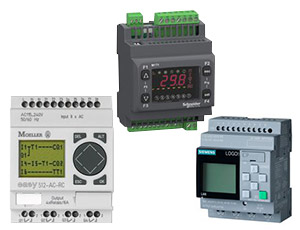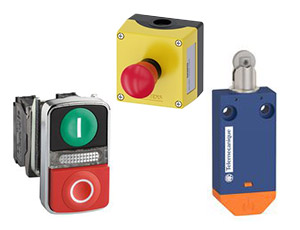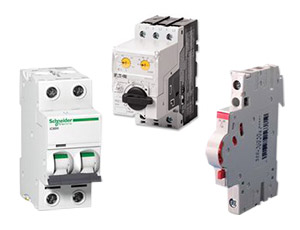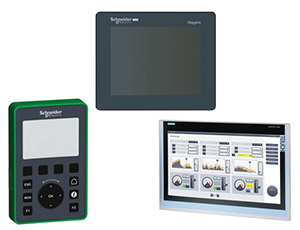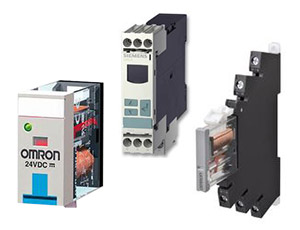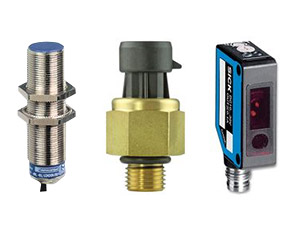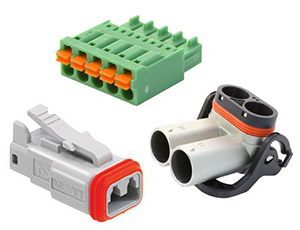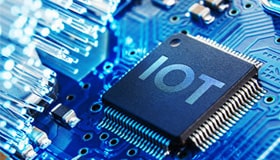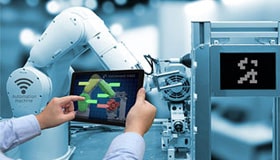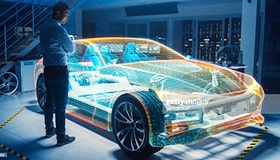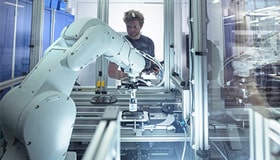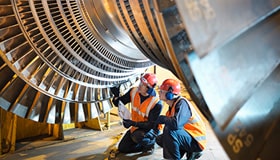Industry 4.0 - Solutions for smart Factory Production Line
A production line refers to a set of sequential operations executed in a factory where materials are sent down a refining process to create an end-product. This outcome is either consumed or is a component of a bigger product that must be assembled to fabricate a finished article.
Smart factories integrate multiple advanced technologies to realize an efficient production line. Advanced technology is used to improve the manufacturing and production process.
New features are continuously developed and integrated into smart factories for smart manufacturing purposes. Automation, virtual reality, machine learning, artificial intelligence, augmented reality, big data, and analytics are a few technologies that push manufacturing plants into a smart manufacturing era.
Creating a Dynamic Production Line Environment
The creation of a dynamic production line ecosystem allows manufacturers to streamline operations and offers them essential flexibility. Production must be in line with company goals.
A smart factory must contain an enterprise resource system that functions as a unified information database. Since big data fuels smart factories, companies must find a way to analyze production line data and also create an environment to store such large amounts of valuable information. Sensors latched to factory equipment extract data and a stable system is vital to access such data and apply them in different ways.
The addition of transformative technologies into production and manufacturing creates a new information and communication ecosystem of engineers, workers, machines, factory floors, assembly lines, and the end product. Each step can be customized for bespoke operational needs.
Smart Production Planning and Control
Production Planning and Control (PPC) uses hierarchical frameworks which introduce various PPC process elements in heterogeneous detail and schedules. This hierarchy augments the ‘drilling down’ approach preferred by business managers when making decisions concerning their production systems.
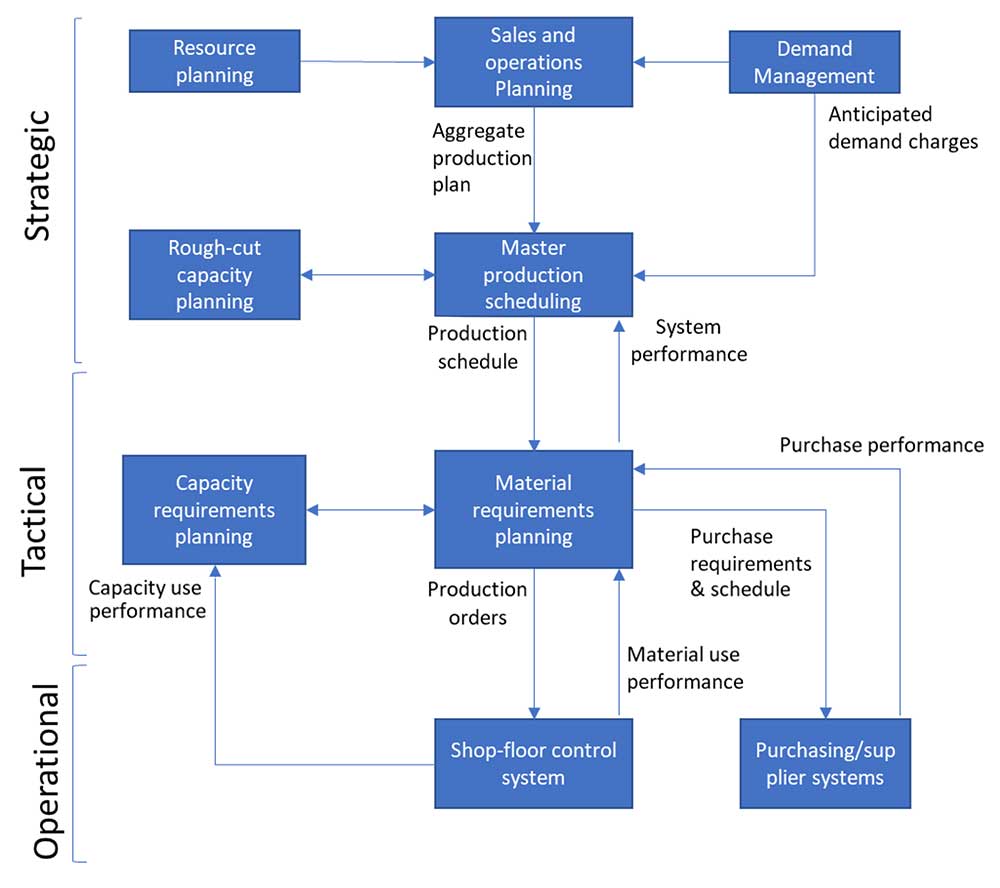
Figure 1: The PPC process
A key strategic level PPC limitation is that it unconditionally assumes that external disruptions like industrial policy changes, weather variations, and global economic swings average out from one year to another. This frequently leads planners and operators to use excess capacity, safety stock, and buffers within the production structure. The aggregated data, furthermore, has varying quality depending on the importance and quantity of data used by the company. Challenges include longer-term data quality (due to fluctuating business environment) and frequency of update among others. In such cases, access to real-time data may not offer any advantage even if they are accurate. A longer span of data is better to enable diverse simulation scenarios.
Conventional enterprise systems like ERP, Advanced Planning and Scheduling (APS) system, or Manufacturing Execution Systems (MES) find it tough to satisfy PPC’s temporal proximity or ‘real-time’ needs. These systems suffer from yet another critical limitation: deviations are aplenty between information contained in such enterprise systems and the reality of the shop floor and the supply chain. Compounding the problem is that such systems are generally configured to collate data from a limited range of production system sources. Such sources are typically production lines and the occasional warehouse inventory. Multiple factors influence performance in production systems. PPC performance is better when data is fed from diverse sources. Industry 4.0 can unravel such complications.
Industry 4.0 predicts a manufacturing future where the product’s end-to-end lifecycle phases are integrated, the internal functional units and manufacturing systems are networked (vertical integration), and the existence of an integrated external value creation network (horizontal integration). Recent technological advances, including Big Data Analytics (BDA), cyber-physical systems, augmented reality, the Internet of Things (IoT), Machine Learning (ML), additive manufacturing, and cloud and edge computing have greased such breakthroughs. The data generated from such in-plant integrated systems will allow real-time control of the factory and its attached supply chain.
An important takeaway of industry 4.0 is autonomous and sentient manufacturing systems. System waste is minimized as real-time plant control enables products to be manufactured as per customer demand. Another notable advantage is the ability of ML and BDA technologies and tools to manage a great diversity of data.
The Smart PPC Concept
As companies are marching towards industry 4.0 to digitize their manufacturing operations, progress is achieved in stages. These stages are computerization, adaptability, connectivity, predictive capacity, visibility, and transparency. For simplification, these six stages are reclassified into three - connected, intelligent, and transparent. These three stages, as shown in Figure 2, are related to production systems’ managers who want better tools to respond accurately and swiftly to business environment changes.
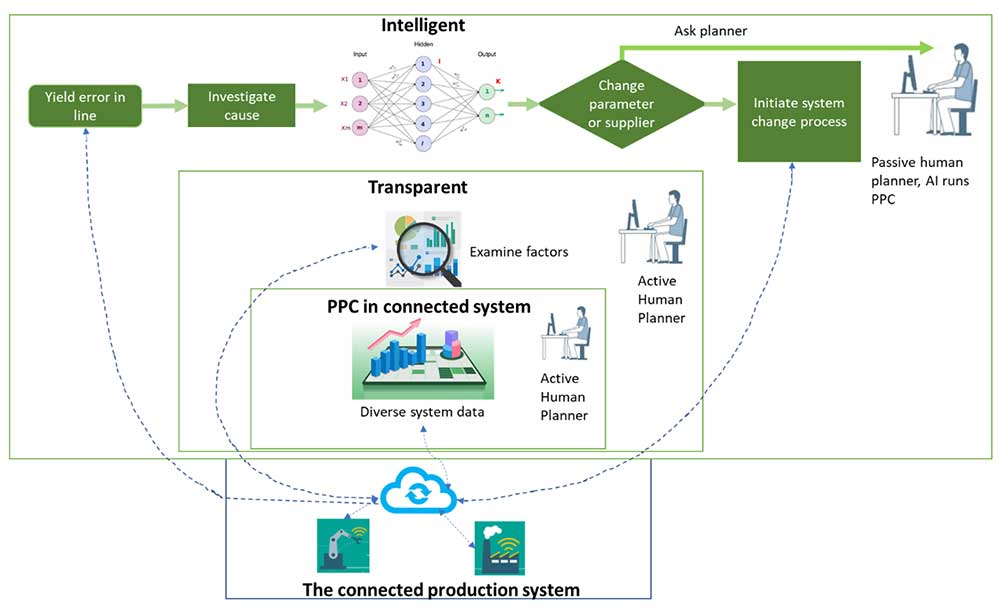
Figure 1: PPC in Industry 4.0
An explanation of the theory underlying each stage, the conceptual model along with a table of probable use-cases for smart PPC is offered in the following subsections.
Connected
PPC process computerization is not new. Spreadsheets and ERP systems are now decades old. Present-day production processes tend to have a larger population of electronic components and also Programmable Logic Controllers (PLCs), enabling greater production process automation.
Conversely, connectivity is only at its nascent stage in an era of digitization and industry 4.0. It continues to grow as networking and sensor infrastructure slowly become more affordable and ubiquitous. Sensing is achieved through the use of telemetry data collection sensors and auto-identification technologies like IoT, Radio Frequency Identification (RFID), and beacons. Furthermore, with the new Internet Protocol Version 6 (IPv6) being the new standard, which theoretically permits up to a massive 3.4*10E38 internet addresses, it is now possible to attach things that were earlier too expensive or complicated to link to the internet. Everything can now be connected, measured, traced, tracked, and improved. The generated data produced by the movement or action of things can be used to improve system design, and to plan and manage operations. Track and trace of resources within a factory and in the supply chain becomes much easier.
IoT sensors, via IoT edge devices, interact with physical production systems by the transmission of compute, status, and location requests, and by receiving instructions and data from cloud infrastructure services. The need for instantaneous reactions compels the use of IoT Edge devices. This is particularly applicable when a higher-than-acceptable device-to-cloud data transfer latency exists, and bandwidth becomes a challenge. Thus, it is now possible to plan and control production systems and supply chains in real-time.
Transparent
A digital model of individual machines can be created if ‘things’ are connected and computerized. It is also possible to make digital models of final products and components that move through production. This is termed a "digital shadow" and can be done for the entire system. The digital shadow in effect represents the production system’s digital state map and accepts data flowing in from that system’s connected elements to present it in a visual form. Production planners and managers can use it to simulate and also plan future system operations and states. A digital twin not only accepts data but also dispatch action directives to the concerned production system. The data can subsequently be gathered either from inside the factory or from truck(s) conveying critical components or raw materials or from sensor-fitted pallets at client warehouses. The production planner can then analyze the data to determine the logistical-problem source(s) at the tactical, strategic, and operational levels. These are done through dashboards fitted with real-time KPIs collated from IoT systems and integrated enterprises.
A digital twin is essentially a physical asset’s digital replica. The asset is fitted with smart devices such as sensors that use industrial IoT to communicate real-time data concerning the asset to its digital twin. The twin traces the physical asset all through its lifetime.
Intelligent
An intelligent system must be able to integrate data from multiple sources concerning itself and also its environment to learn and then autonomously predict events that may influence its execution of predetermined goals. This implies, in production, being able to anticipate production delays, demand reduction, and supplier delays among others so that a performance failure can be averted. Recent ML industrial interests have led to notable advances that make such methods and technologies more feasible for PPC compared to the past. ML comes in three types - supervised, reinforcement learning, and unsupervised. All three types were subjected to PPC research – with reported limited empirical case studies. Unsupervised and supervised ML methods have seen planning and control applications for anticipating supply disruptions. Reinforcement learning was experimented on for real-time scheduling.
These cases have also been applied to the occasional static PPC problem, whereas research that analyzes real-time PPC system dynamic cases were rare. During the last decade, however, DL has received considerable scrutiny from the software industry and has also witnessed remarkable application in industries other than manufacturing. Multiple published studies, before that, investigated the utilization of ML techniques in PPC system subsets. Smart systems can thus be pre-programmed to not only run independently but also comprehend and improve sans human intervention.
Industry 4.0, Smart Cities and Clean Energy are just some of the segments creating a buzz in the industrial space. Creating a solution is one thing, getting it to market quickly can mean the difference between success and failure. Farnell offers tools to speed the development process, including:
Development Kits:
Development help simplify the design process and greatly reduce time to market.
IoT Starter Kit:
The Industrial Internet of Things (IIoT) is the single largest driver behind the latest industrial revolution.

